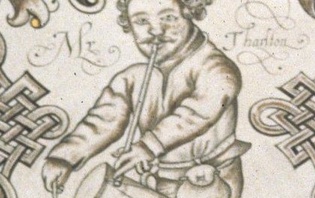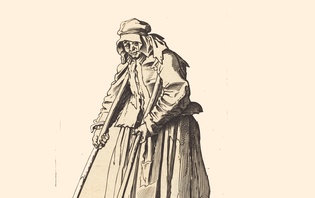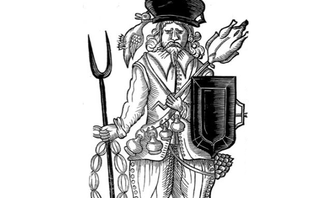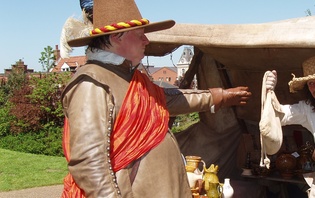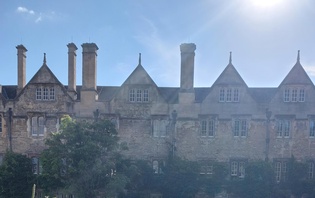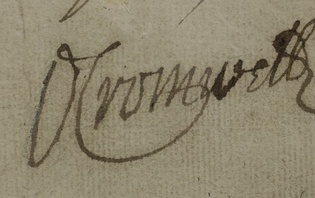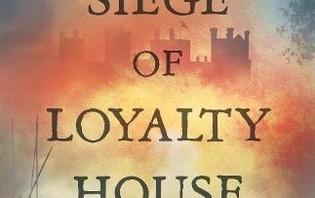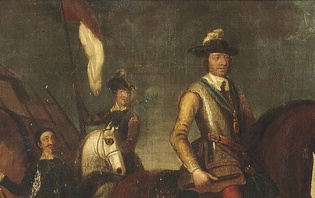Allegiance and the Art of Survival: Colonel Henry Farr
In the late summer of 1642, as civil war in England became ever more likely, people at all social levels were forced to make hard choices. Few individuals were so committed to King or Parliament as to relish the prospect of fighting against their fellow countrymen. Areas supposedly dominated by parliamentarians or royalists all had inhabitants who harboured sympathies for the other side, and the allegiance of many others wavered according to their view of political events. Traditional county gentry, who had been conditioned to see themselves not simply as leaders but as nursing fathers of their communities, often became disaffected as the demands of the war effort ravaged their localities. Many of these county gentry were Presbyterians, the most socially conservative type of Puritan. Presbyterians mostly favoured Parliament in 1642, but as the war dragged on many found themselves torn between their religious convictions and fears of political or social instability. After 1644, alarmed by the growing influence of radicals within the parliamentarian alliance, more and more Presbyterians detached themselves from Parliament and adhered to Charles I. The rash of defections which occurred at the outset of the Second Civil War of 1648 threatened to bring down the parliamentarian cause altogether. In this blog, David Appleby surveys the career of one of these defectors: Colonel Henry Farr. As several documents in our Civil War Petitions database show, Farr played a leading role in the events of that momentous year.
When Thomas Peatchey presented his petition to the Essex justices in 1678, he also submitted a certificate signed by several of his old commanders. Chief among these was ‘the Right Honourable Colonel Henry Farr’, in whose service Peachey had voluntarily enlisted in 1648. Farr and two other gentlemen confirmed that the Blackmore labourer had served in the royalist forces during the siege of Colchester. Colonel Farr affirmed that Peachey had been motivated by ‘his loyalty to our gracious sovereign lord King Charles the First of ever-blessed memory’. This effusive rhetoric was rather ironic given that Farr himself had begun his military career by taking up arms against the King.
Henry Farr was born around 1597, the eldest son and namesake of Henry Farr, and his wife Prudence. The elder Henry, an esquire of Great Burstead, Essex, died in 1609. There are indications that the Farr children were made wards of court (as their father had been in his youth). It is clear from the elder Henry’s will that he intended that his children’s great uncle – another Henry Farr – and his cousin Thomas Harrison should act as their guardians.
At some point over the succeeding years young Henry Farr came within the orbit of the powerful Rich family of Leez Priory, near Chelmsford. Robert Rich, 2nd Earl of Warwick, succeeded to the earldom in 1619. Like his late father, Warwick had an impressive portfolio of business interests in America and the Caribbean, and his semi-piratical activities brought him such huge wealth and influence that he was nicknamed the ‘King of Essex’. The earl initially enjoyed good relations with Charles I and the King’s leading courtier, the Duke of Buckingham. In 1625, in the midst of a Spanish invasion scare, he was charged with organising the county’s defences. Warwick was energetic and efficient, but his puritanical zeal for Protestant reformation soon led him to oppose royal policy. Charles stripped the Earl of his county commission in 1627. Over the next decade Warwick became increasingly prominent in the political struggle against the Crown.
In 1642, with the country on the brink of civil war, Parliament began to nominate its own Lord Lieutenants in English and Welsh counties, intending that they should replace the King’s official appointees. The Earl of Warwick was chosen to be Lord Lieutenant of Essex. He immediately appointed Henry Farr to assist him as a Deputy-Lieutenant. When Warwick began to assemble a second army to complement the main parliamentarian field army (commanded by his cousin the Earl of Essex), Farr, like hundreds of other Essex men, volunteered for military service. Being already a captain in the Essex Trained Bands, it is no surprise to find that he was appointed to command a foot company in Warwick’s embryonic army. Farr was prominent in preparing a loyal address to the Earl, in which he and his fellow officers declared that all well-affected gentlemen of Essex were ready to entrust ‘our Religion, our Lawes, and all into the hands of that great and most faithfull Councell the Parliament’. They were clearly not willing to trust King Charles, whom they noted had chosen to follow ‘other Counsels’.
All was well until Warwick decided to replace the Essex officers with experienced professionals. Captain Henry Farr led the protests, alleging that the Earl had thereby alienated ‘the hearts of the Essex Souldiers, who came with willing minds to performe Noble service’, and suggesting that ‘the change of their Captaines hath also changed their affections.’ There is no doubt that the rank-and-file were demoralised by this decision, and Warwick had to tread carefully in order to avoid mass desertion. The Earl diplomatically assured Farr that although he had every confidence in the Essex officers’ courage and zeal, he still felt it would be better if they concentrated on the defence of their county, and handed their volunteers over to Flanders veterans demonstrably more experienced in the art of war. Despite this spat, it is clear that Warwick still trusted his protégé, for Farr was soon after gazetted Lieutenant-Colonel of the Earl’s own regiment in the Essex Trained Bands. In June 1643 he was appointed to sit on the county committee for raising money, as well as that charged with overseeing the sequestration of royalists’ estates.
An incident in the late summer of 1643 provided further evidence that Farr’s attachment to his county community was stronger than his adherence to Parliament. The Earl of Essex’s field army had lost so many horses during its early campaigns that officers were sent into the provinces to requisition replacements. A Lieutenant Brazier arrived in Essex, and proceeded to raid the stables of well-affected Essex gentlemen as well as royalists. Farr, acting in his capacity as a Deputy-Lieutenant, intercepted Brazier as he was making his way back to the army, confiscated the officer’s commission, and returned the animals to their owners. Parliament could not afford to ignore such a direct challenge to its authority. The Earl of Warwick was directed to strip Farr of all his county offices, and deliver him into the custody of the Sergeant-at-Arms of the House of Commons.
Farr still had powerful friends on the Essex county committee, who immediately began to lobby for his reinstatement. He also retained Warwick’s complete confidence, for by October 1643 when the three foot regiments of the Essex Trained Bands were mustered at Maldon, he was reinstated as Lieutenant-Colonel of the Earl’s regiment. For the next four years Henry Farr appears to have performed his duties diligently. However, like many conservative Presbyterians, he was rapidly losing whatever enthusiasm he had once had for the parliamentarian cause. Matters came to a head in 1648.
There were many reasons for the outbreaks of civil disorder around the country over the winter of 1647. The more rigid Presbyterians believed that the parliamentarian cause was being hijacked by political and religious radicals, and they feared and distrusted the New Model Army. The wider public were aggrieved that heavy taxation had continued despite the cessation of hostilities, and resented the intrusive, autocratic, and often rapacious activities of the parliamentary county committees. Royalists managed to turn this discontent into armed insurrection in Wales and Kent, whilst the King enticed a section of the Scottish Covenanters to engage to invade England on his behalf. Parliament gave Oliver Cromwell half the New Model Army to repress Wales and meet the Scots, whilst Lord Thomas Fairfax took the other half into Kent to deal with the situation in that county.
On 4 May 1648 Sir William Hicks and Farr’s subordinate, Major Stephen Smith led two thousand petitioners from Essex to present a mass petition to Parliament. Their petition outlined numerous grievances and urged parliamentarian leaders to resume their negotiations with the King. The petitioners left Westminster without incident, but back in Essex royalists and disgruntled Presbyterians were actively inciting the local population against Parliament. On 4 June, the Essex parliamentary county committee assembled in Chelmsford to consider what to do about the unrest. Henry Farr and Stephen Smith swiftly mustered the Earl of Warwick’s regiment, marched into the town, and seized the committee. Unfortunately for Farr, four committee members were absent. As soon as they received news of the coup in Chelmsford, Sir Thomas Honywood, Colonel Harlackenden, Colonel Cooke and Colonel Sparrow hurriedly assembled the two remaining Essex Trained Band regiments for Parliament.
There was no going back for Henry Farr. Royalist veterans and disaffected civilians were now flocking to Chelmsford, foremost among them Sir Charles Lucas. Farr and Smith declared for the King, and placed themselves and their men under Lucas’s command. They were soon joined by the Earl of Norwich, who brought in around 500 Kentish royalist insurgents, these being all that was left of the force mauled by Tom Fairfax in battle at Maidstone. Now numbering around 5,000 men, the royalists moved north towards Colchester. They only intended to remain in the town long enough to recruit more men. However, the next morning, 13 June, they were astonished to find themselves trapped: Fairfax had gathered his forces and moved into northeast Essex with amazing rapidity. The royalists were faced not by Colonel Whalley’s cavalry brigade which had hitherto monitored their march, but by Fairfax’s full force of veteran New Model regiments, reinforced by the two regiments of the Essex Trained Bands which had remained loyal to Parliament.
Farr and Smith placed their Trained Band regiment across the Lexden road to the west of the town, in an effort to delay the parliamentarian advance. The militiamen fought valiantly, but were eventually outflanked and overwhelmed. In the confusion Farr and Smith managed to lead some of their men to the safety of the town walls. Many others lay dead on the Lexden road, and 200 were taken prisoner, but they had at least given their new royalist comrades time to put the town into a defensive posture.
After an unsuccessful attempt to storm the town, Fairfax settled down for a long siege. He soon received further reinforcements in the shape of 3,000 infantry from the Suffolk Trained Bands. Parliamentarian journalists had already singled out Farr for particular excoriation, branding him an apostate, and his men a ‘rabble of mutineers’. As a prominent turncoat, there was little doubt of what awaited the Colonel should he fall into parliamentarian hands.
Colchester’s 10,000 inhabitants were almost entirely parliamentarian in their sympathies. They had even less cause to love the unwelcome royalist presence after three months of siege, starvation and disease. At the end of August news arrived that Cromwell had crushed the Scots Engager army at Preston. Lord Norwich and Charles Lucas now knew that continued resistance was futile. Fairfax had offered relatively generous surrender terms at the beginning of the siege, but had been rudely spurned. He was now only willing to allow the royalist garrison to surrender ‘at mercy’. This meant that he reserved the right to treat any prisoner as he saw fit. There were numerous breakouts as the defenders sensed the end was near. Finally, on 28 August the 3,391 royalist troops still remaining in the town were obliged to surrender their arms and gather at the east end of High Street. All senior royalist commanders were ordered to present themselves at the King’s Head tavern in Head Street. Farr attempted to escape, but was quickly recaptured and escorted to the King’s Head.
Fairfax held a council of war, at which it was decided to make an immediate example of Sir Charles Lucas, Sir George Lisle, Sir Bernard Gascoigne and Colonel Farr. The remaining royalist commanders were to be taken to London for a formal trial. However, when Colonel Ewer arrived at the King’s Head to collect the four men selected for execution, he was unable to locate Henry Farr. The Colonel had staged his second escape of the day. Lucas and Lisle were shot by firing squad. Gascoigne (whose real name was Bernardino Guasconi) was reprieved after it was discovered that he was a subject of the Duke of Tuscany.
Parliamentarian writers seem to have been somewhat confused as to Farr’s fate. Some thought that he was still being held in custody. One journalist informed his readers that Colonel Farr’s life had been spared in order that he might be coerced to bear witness against the Earl of Warwick. The ‘King of Essex’ had certainly been embarrassed by the fact that several of his closest associates – not least his brother the Earl of Holland, and his erstwhile protégé Henry Farr – had turned royalist. However, Warwick himself had played a vital role in Parliament’s victory in the Second Civil War of 1648, having used all his influence with the parliamentarian sea captains and ships’ crews to ensure that the bulk of the fleet remained loyal to Parliament.
Unsurprisingly, Farr went into hiding. It is very likely that he fled into exile, along with many other royalist fugitives. He resurfaced in England just before the Restoration, engaging in a legal dispute over property in Buttsbury, near Chelmsford in Essex in 1659. In July 1660 he petitioned the restored House of Lords, requesting that the peers order his old adversary Sir Thomas Honywood and other ex-parliamentarians to pay him compensation for the financial losses he had suffered during the Civil Wars and Interregnum.
One of the problems facing Charles II after the restoration of the monarchy in 1660 was how best to reward and recompense his father’s old supporters. Henry Farr was made Deputy-Governor of Landguard Fort on the Suffolk coast. He was thereafter responsible for the day-to-day running of the fort, deputising for the titular Governor, Charles Rich, 4th Earl of Warwick. Rich had recently succeeded to the peerage following the death of his elder brother and their father – Farr’s old mentor; the Restoration threw up many such ironies. The Restoration authorities were notoriously reluctant to allocate sufficient funds to such establishments, and in 1662 Farr was forced to petition the Lord Treasurer for money to pay, feed, clothe and equip his neglected garrison, many of whom had been reduced to sleeping on bare boards. Despite Farr’s efforts, the men’s plight was not ameliorated until a further petition in 1663 elicited a payment from the new Hearth Tax. Growing tensions with the Dutch resulted in more ordnance being installed in the Fort. Farr was confirmed as Governor in December 1664 (his name is incorrectly transcribed as ‘Fane’ in the Calendar of State Papers). In April 1667 Governor Farr’s garrison was transferred to Yarmouth. He handed over Landguard Fort to another royalist veteran, Captain Nathaniel Darrell. It was therefore Darrell, not Farr, who successfully defended the Fort with two companies of the Lord High Admiral’s Regiment (later the Royal Marines) when the Dutch attempted to capture it that summer. Nevertheless, Farr deserves credit for ensuring that Darrell had inherited a fort which was in a good state of repair and properly supplied.
Henry Farr was now well advanced in years. He had some independent means, but had clearly lost a great deal of money during the Civil Wars and Interregnum. Much of his remaining fortune had been devoted to alleviating the suffering of the wretched garrison at Landguard Fort. Like so many other needy royalist veterans he was now necessitated to petition for financial support. Documents in the State Papers bear testament to the old man’s tenacity, as well as his remarkably robust constitution:
In October 1682 Farr wrote to Charles II to thank the King for granting him a place in the Charterhouse, ‘but fears never to live to enjoy it, so many others being to be preferred before him’. Farr reminded the King that he had a large family to look after: his latest wife had recently died giving birth to his twenty-fourth child (remember he was 85 years old by this time!). He begged ‘a few crumbs of mercy for the sake of his dear children’, and declared that he would not trouble the King with a description of ‘his services to the late King and himself, though great.’ A year later, Charles Fox, paymaster general was ordered to provide a pension of 4s per day to ‘Col. Henry Farre in consideration of his long and constant loyalty, the imminent hazard of his life at Colchester in 1648 and the total ruin of a plentiful fortune, besides his great age, he being 85 years old.’
In December 1684, the old Colonel was referred to the Lords of the Treasury, having petitioned to have ‘some further allowance besides the 4s per day now paid him, in consideration of his great losses and sufferings for his loyalty, he having lost to the value of £10,000 at Colchester and having 17 children.’
Henry Farr was still alive in July 1687, when he was listed in the Calendar of Treasury Books as receiving a pension of £73 per year. It is tempting to believe that he was the Henry Farr Esq of Brentwood, Essex whose will was proved 2 January 1688, but further research is needed to confirm this. Only two daughters are mentioned in this will – so if this is the same man, perhaps Henry Farr, the consummate survivor, survived them all.
What of Henry Farr’s men? Apart from Thomas Peatchey, several other members of his ill-fated Essex Trained Band regiment are known to have petitioned the authorities after the Restoration. John Hoskins of South Hanningfield, John Skinner of Runwell, and Robert Hoskins of Chelmsford all received gratuities from the Essex Quarter Sessions in July 1661, as did a widow called Margaret Alsoppe, together with John Sweeteing, Thomas Sharpe and Henry Stokes. William Witham (aka Wytham), a blacksmith from Writtle, near Chelmsford, petitioned in 1674 and again in 1675. He had been a corporal in Stephen Smith’s company throughout the siege. He and all the other petitioners waxed lyrical about their unswerving loyalty to ‘Charles the First of blessed memory’. It would be interesting to know how they had explained themselves to their parliamentarian captors back in 1648. Parliamentarian journalists claimed that Farr had drawn ‘many an innocent man of the Trained band under the pretence to muster, not knowing they should ingage in matter of blood, he never discovering unto them what his intentions were of ingaging them in a Warre against the Parliament.’ Like Farr, it would seem that his men may also have tailored their narratives to suit the changing times.
[I am very grateful to my brother Roger Appleby for additional research on Henry Farr’s father.]
ADDENDUM:
Since this blog was published, Dr Christopher Thompson has kindly contacted us with some interesting information regarding the relationship between Henry Farr and Robert Rich, 2nd Earl of Warwick. Documents held in the British Library [BL Lansdowne 662] show that Walter Farr (who was either Henry’s grandfather or great-grandfather) was the receiver-general of Sir Richard Rich, 1st Baron Rich of Leez Priory (the great-grandfather of the 2nd Earl of Warwick). Following this lead, we have discovered that the Farrs’ manor of Great Burstead was originally in the possession of Sir Richard Rich, who alienated it to Walter Farr and his heirs. The longstanding ties between the two families provide further clues as to why the Earl of Warwick continued to support Henry Farr despite the latter’s difficulties with the parliamentarian authorities – at least, until Farr’s defection to the royalist cause in 1648
As regards Henry Farr’s escape from Colchester in 1648, Dr Thompson advises that that the reason parliamentarians could not find Farr in the King’s Head when they went to fetch him for execution was because he had found a good hiding place – namely, an oven!
Further reading
Robert Ashton, Counter-Revolution: The Second Civil War and its Origins 1646-8 (1994).
Clive Holmes, ‘The affair of Colonel Long: relations between Parliament, the Lord General and the county of Essex in 1643’, Transactions of the Essex Archaeological Society, 3rd series, vol. 2, no. 3 (1970), pp. 210-215.
Andrew Hopper, Turncoats and Renegadoes: Changing Sides during the English Civil Wars (2012).
Frank Hussey, Suffolk Invasion: the Dutch Attack on Landguard Fort, 1667 (1983).
Brian Lyndon, ‘Essex and the King’s cause in 1648’, The Historical Journal, vol. 29, no. 1 (1986), pp. 17-29.

